And…we’re back! Last week we covered How to Butcher & Process a Lamb – Part 1 where I showed you how to actually kill and break down a lamb. It was adventurous, that’s for sure! Now, we’re on to how to process the lamb into the most desirable cuts.
The first time we butchered a lamb, we just cut all the meat up into random pieces. The meat still tasted fine, but in my experience, it’s definitely more enjoyable if you can cut up meat into familiar pieces. Also, it really helps stretch the meat a bit when you do it this way.
Let’s get started!
STEP 1 – Now, typically, you’d have two shoulders and a neck, but we gave the two shoulders to the friend who helped us butcher, and we cut the neck off and are saving it to make broth. Step 1 is basically to remove the front legs (which is referred to as the shoulder) and the neck.
STEP 2 – Find the top of the pelvic girdle and cut all the way to the spine.
STEP 3 – Do the same on the other side.
STEP 4 – Using a saw, cut through the bone.
STEP 5 – Count six ribs down from the head of the body and cut down all the way to the spine.
STEP 6 – Do the same on the other side.
STEP 7 – Using a saw, cut through the bone.
STEP 8 – Now find where the ribs end, and cut all the way through both sides, and through the spine just like before.
STEP 9 {BREAKING DOWN THE LOIN} – The part that doesn’t have ribs is called the loin. It looks like this.
STEP 10 – Flip the loin over and peel back the layer of fat off of it. This is not to make the lamb more low-fat, but it’s to use later and render down as a nutrient-dense cooking oil.
STEP 11 – You can trim off any end sections where the meat gets really thin, feel free to grind this for ground lamb meat.
STEP 12 – Now you have a big pile of fat to use for later:)
STEP 13 – Now turn the loin back over.
STEP 14 – Fold the right side of the meat over.
STEP 15 – Now, fold the left side over.
STEP 16 – Lay the wrapped loin on it’s side and feel for a space in between each bone.
STEP 17 – As you feel the space between each bone, cut down to the spine. Do the same to the other side.
STEP 18 – Unroll the loin and using a saw, cut through the spine. Now you have lamb chops! (Finished picture at the end)
STEP 19 – Working on the lower rib section, measure about half-way down the ribs with your fingers.
STEP 20 – Using your saw, cut through the rib bones.
STEP 21 – Now you have a middle rib section, and two end sections.
STEP 22 – Take the middle rib section, turn it over, and slice down the center to the middle of the spine.
STEP 23 – Peel it back (you may have to use your knife to help cut away the meat from the spinal bones. Try to get as much meat away from the spinal bones as possible.
STEP 24 – Bring the saw out again, and slice down the side of the spine, trying to save as much meat as possible.
STEP 25 – Same thing on the other side.
Repeat steps 19 – 25 for the top rib section.
STEP 26 {FRENCH the RIBS SECTIONS} To french the ribs, you’ll need to slice the membrane on the inside of the rib section about 2 inches down.
STEP 27 – Repeat down the entire rib section.
STEP 28 – Cut away the leftover meat/fat. You can use this in your fat rendering or grind it into sausage.
STEP 29 – Now you have a rack of lamb! This part is really optional. You don’t have to cut away the meat, but it looks pretty cool, am I right? I laid two racks of lamb together so they look all pretty for ya’.
STEP 30 – Now you’re going to remove each leg. It’s pretty simple, you’ll just cut down on the side of the tail all the way to the hip bone.
STEP 31 – Once at the hip bone it should break off. Slice through the rest of the meat and skin till it breaks free.

STEP 32 – Now you have two legs of lamb.

Here’s the FINAL PICTURE! The only thing missing from this picture is the shoulder pieces, and the heart & liver.
Let’s go over the weight breakdown:
Total lamb chops – 2 lb. 11oz
Total ribs – 8lb. 5oz
Total legs – 11lb. 1oz.
Total shoulders – 10lb. 4oz.
Total internal fat – 3 lb. 8oz.
Total neck – 3lb
Total spine – 2lb 9oz
plus kidney, liver, heart
Total weight of lamb cuts = 41 lbs. 4 oz.
How much did it cost to raise this lamb ourselves? Well, we didn’t have to purchase him, we already owned the mother, and we bred her for a $25 stud fee. She had two lambs, and we gave one away for free.
We didn’t have to pay for feed, because we had about a 1/2 acre of fresh grass for him and his mother to eat. We did purchase a salt block, which cost $5.
Total cost spent on the lamb would be $30. We acquired 41 lbs. of meat/fat. So you could say that this grass-fed lamb cost us under a $1 per pound. Pretty amazing, right?
Wow, I need a nap! Have you ever butchered and processed an animal before?
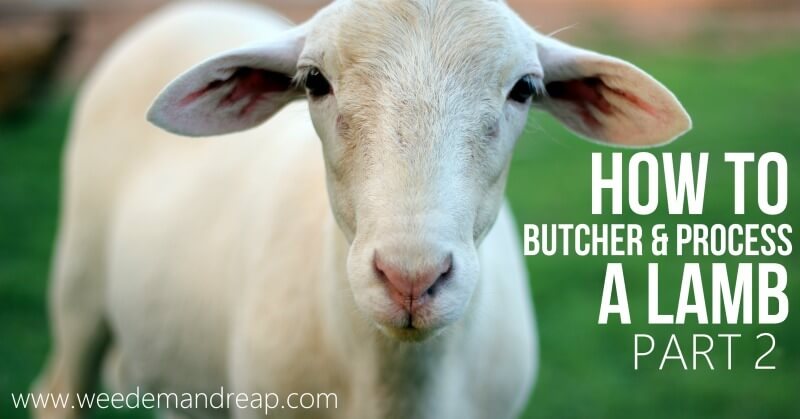
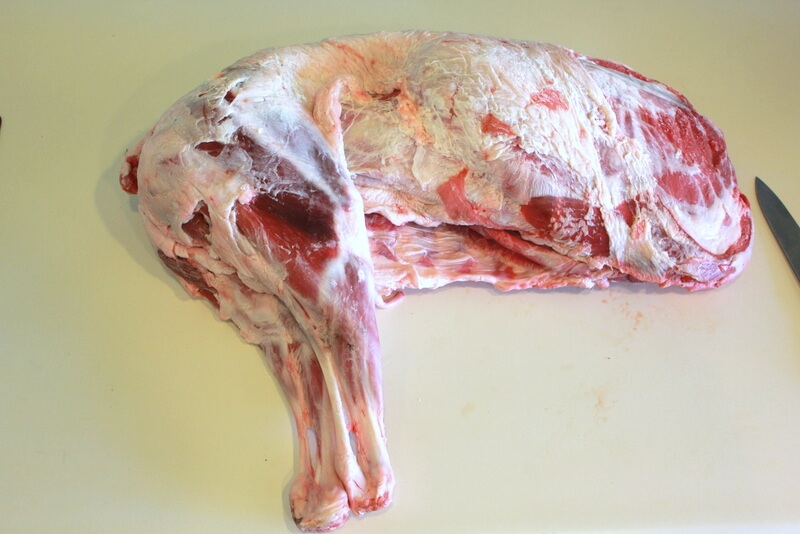
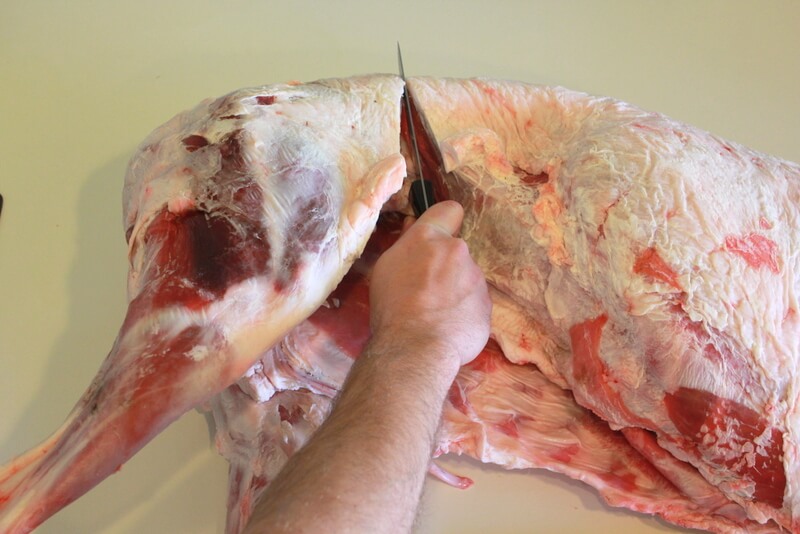
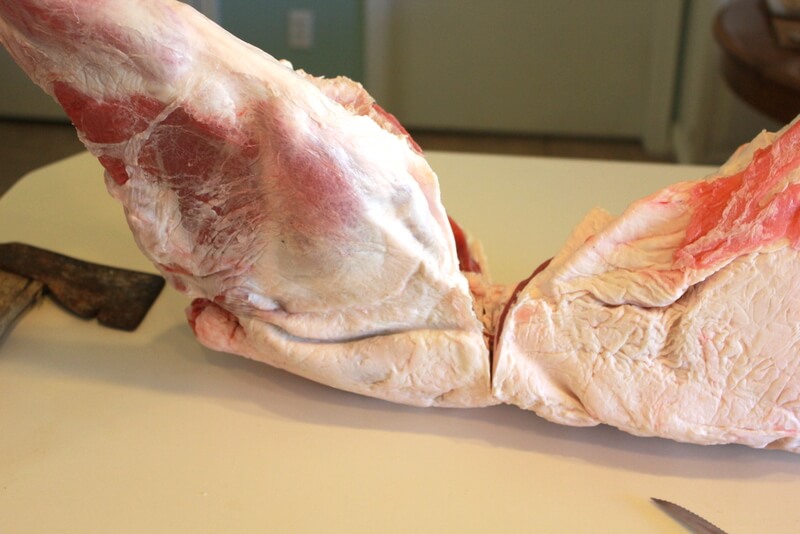
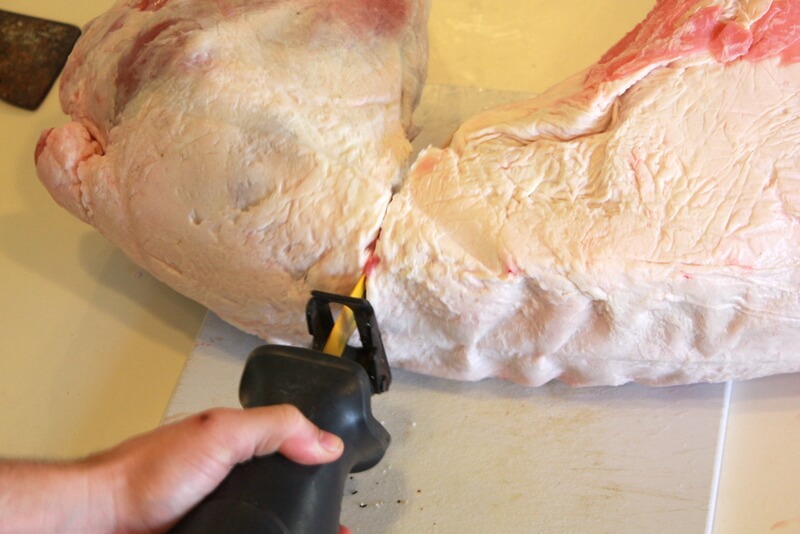
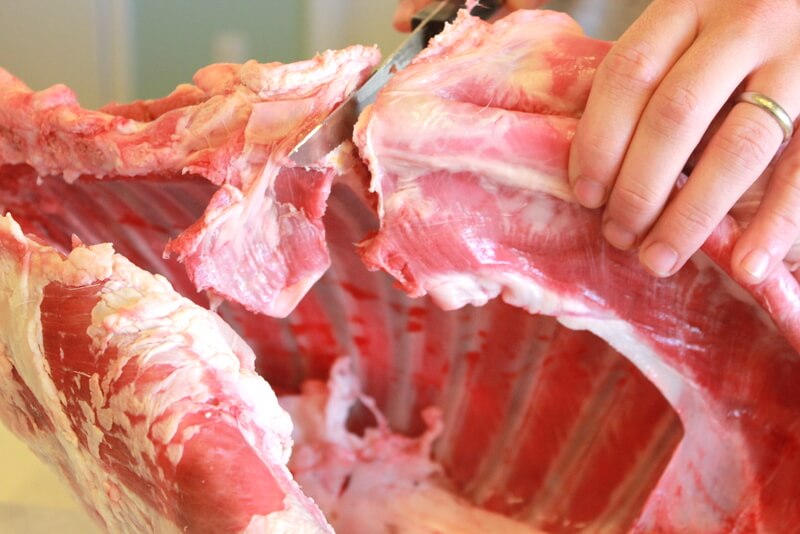
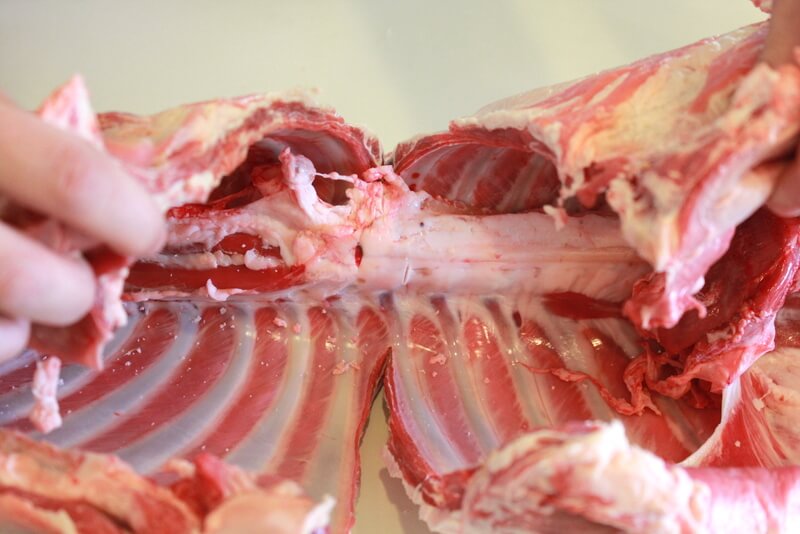
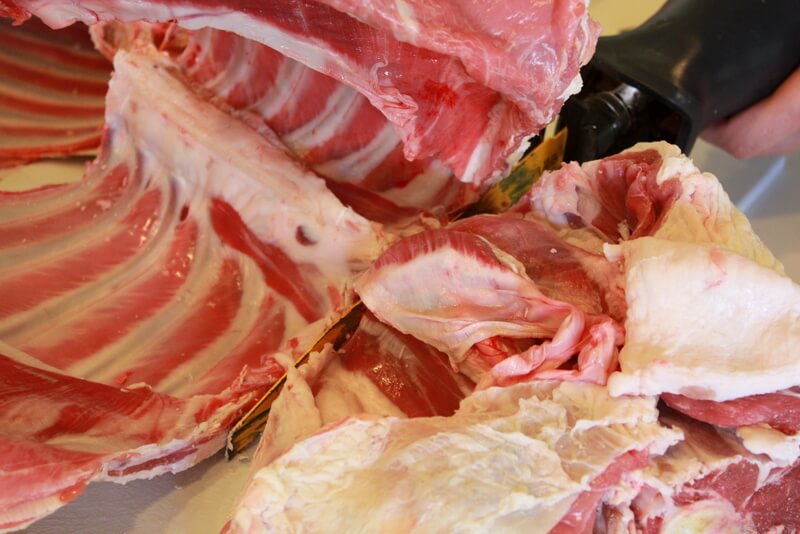
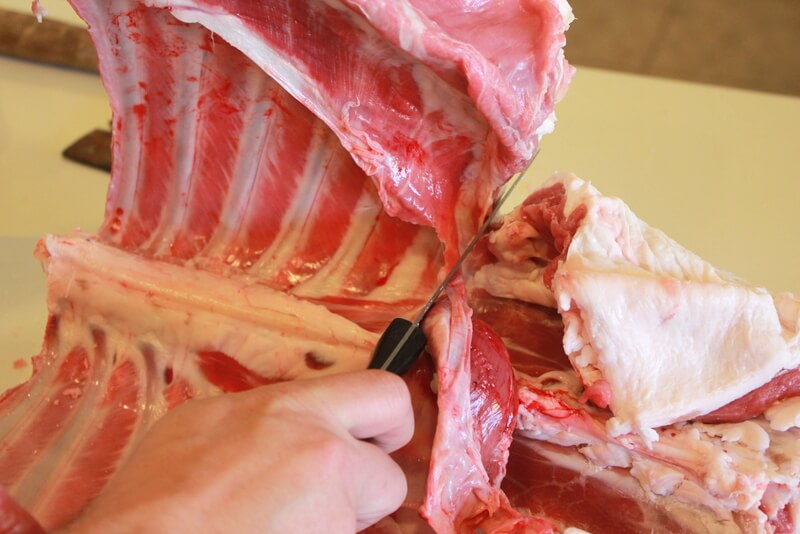
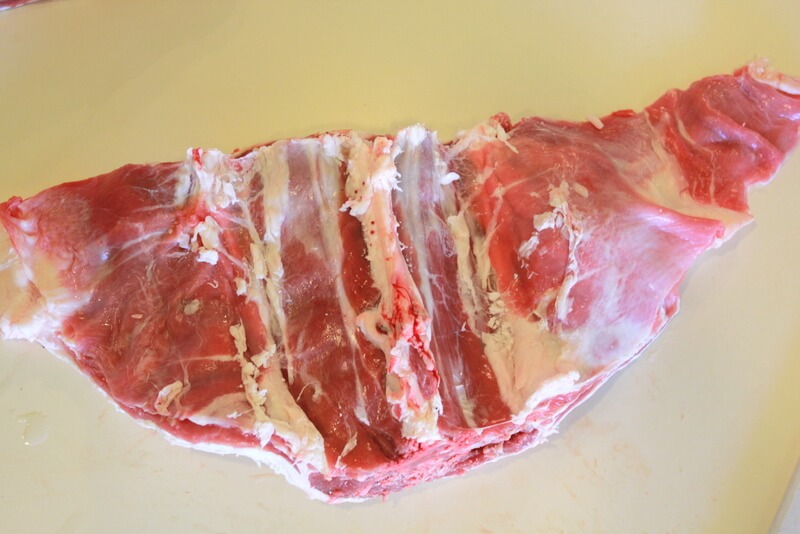
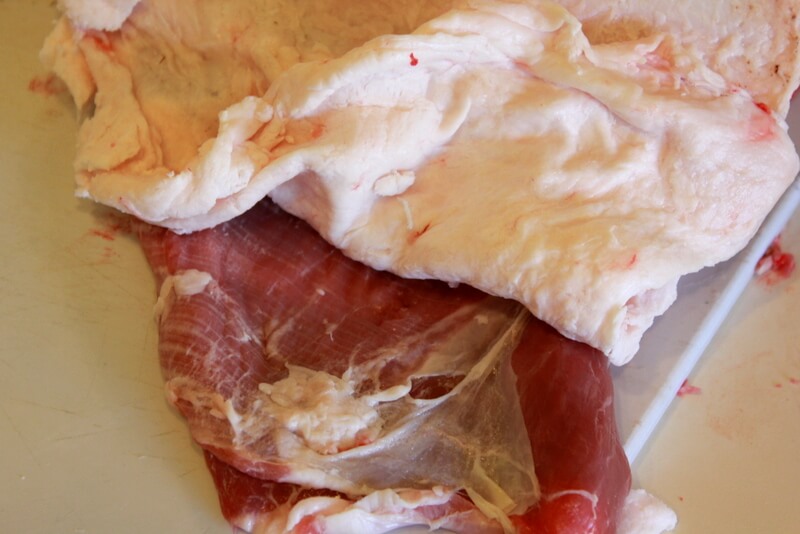
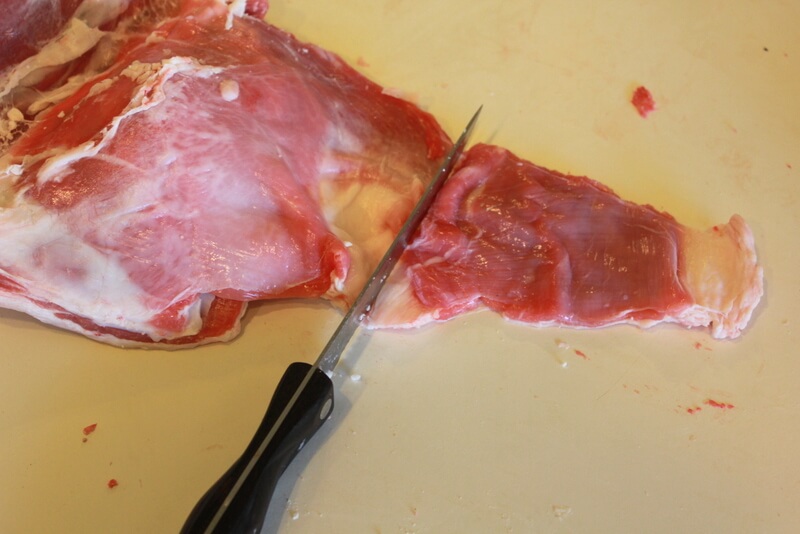
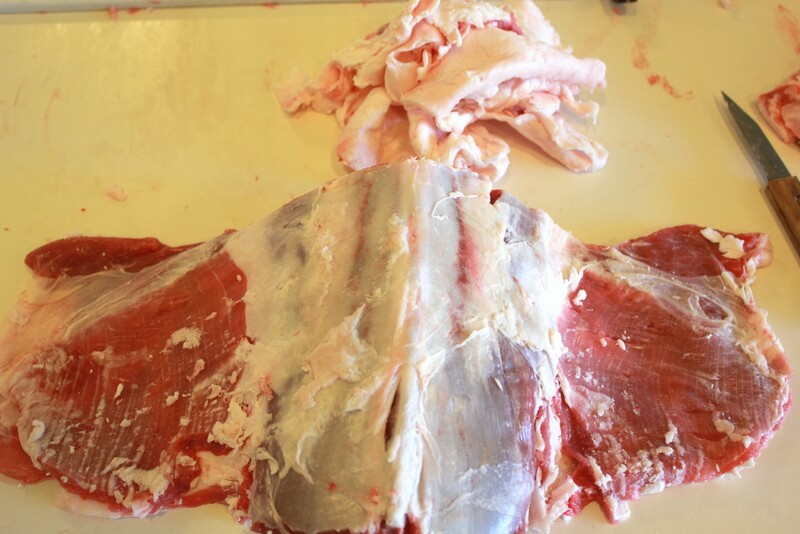
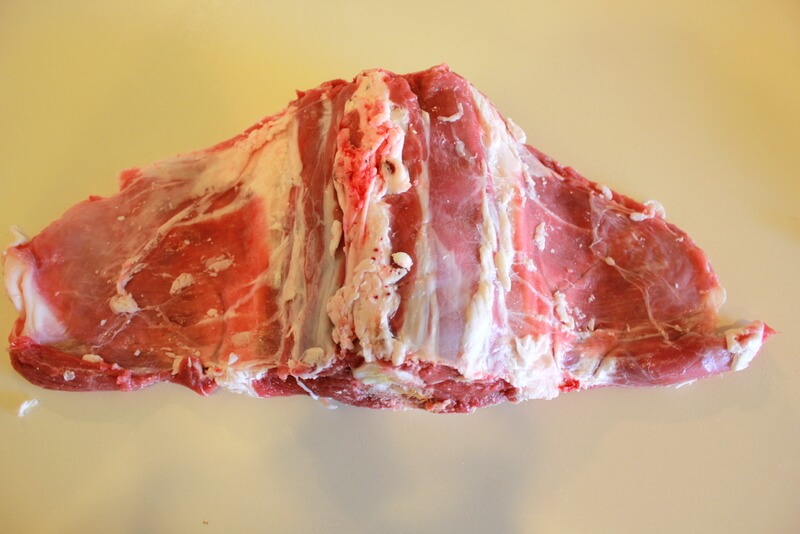
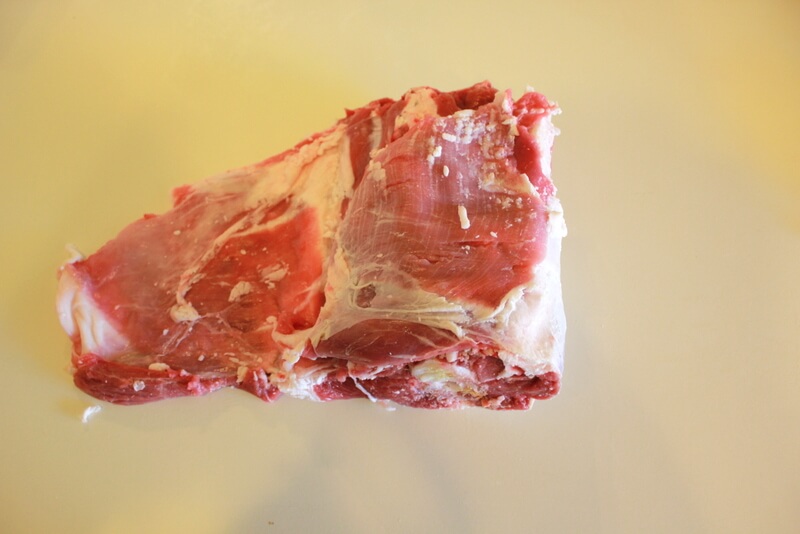
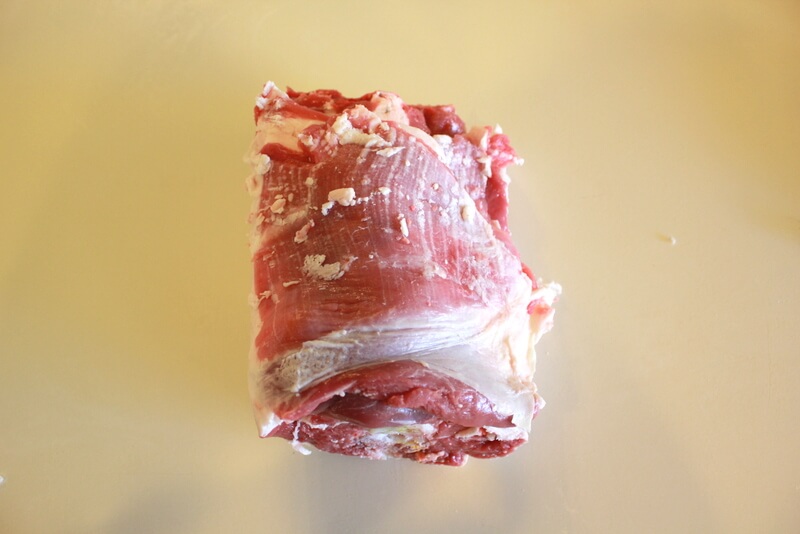
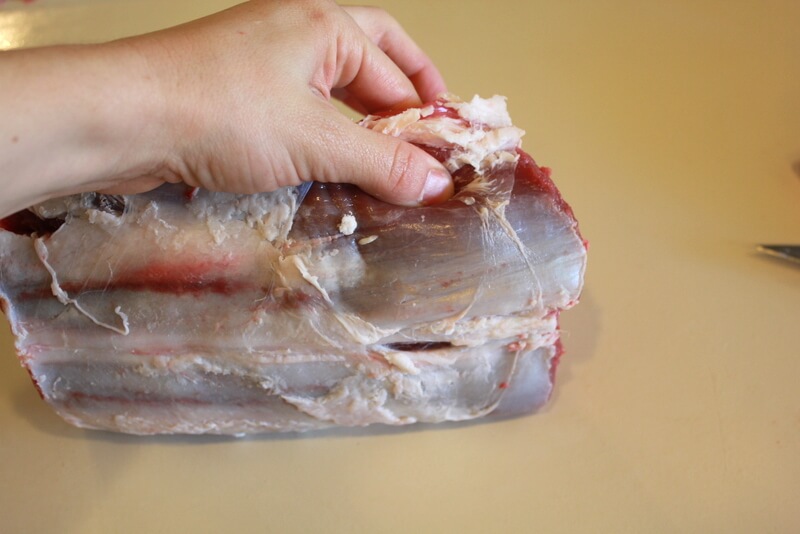
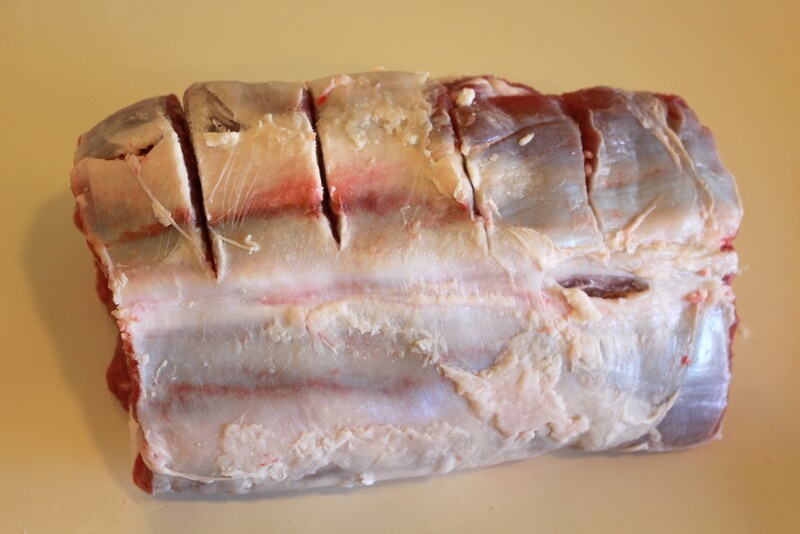
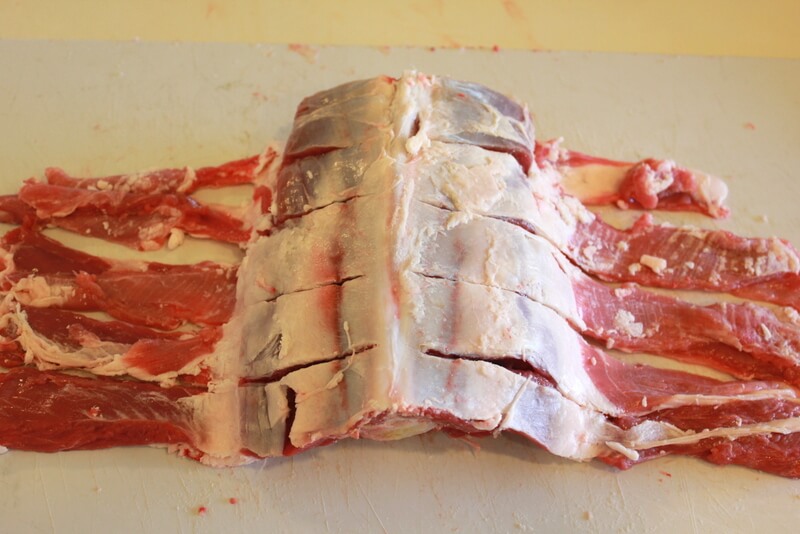
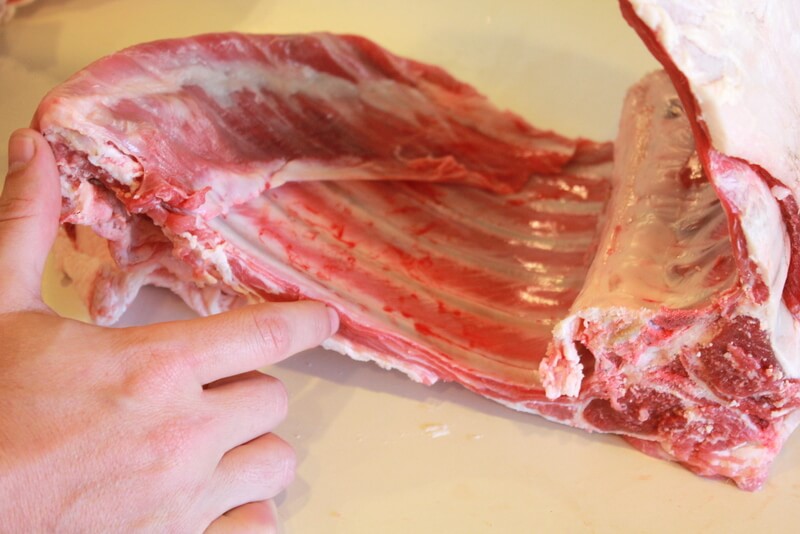
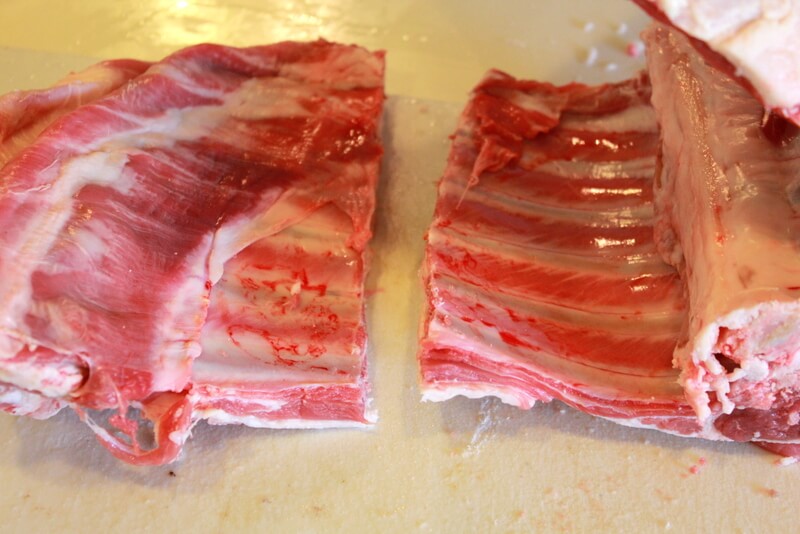
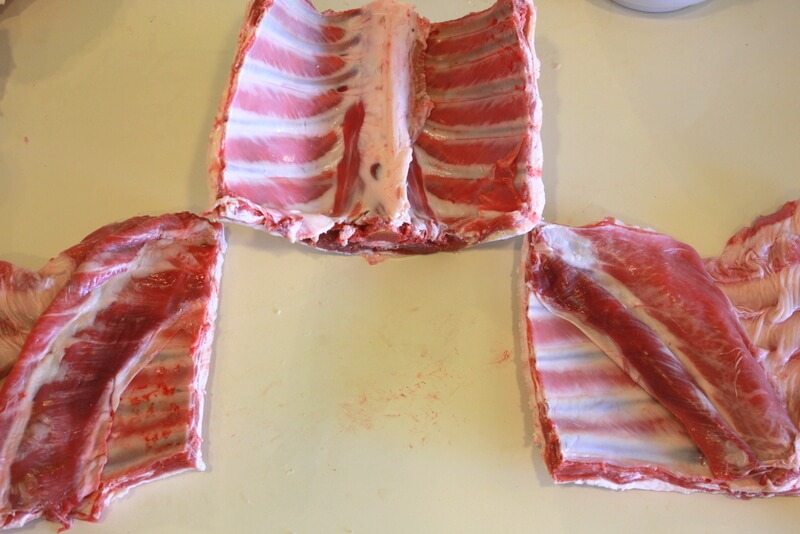
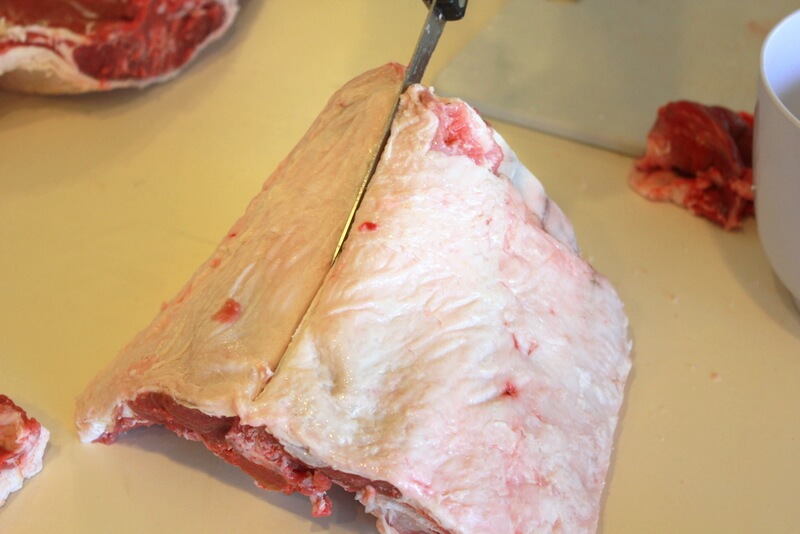
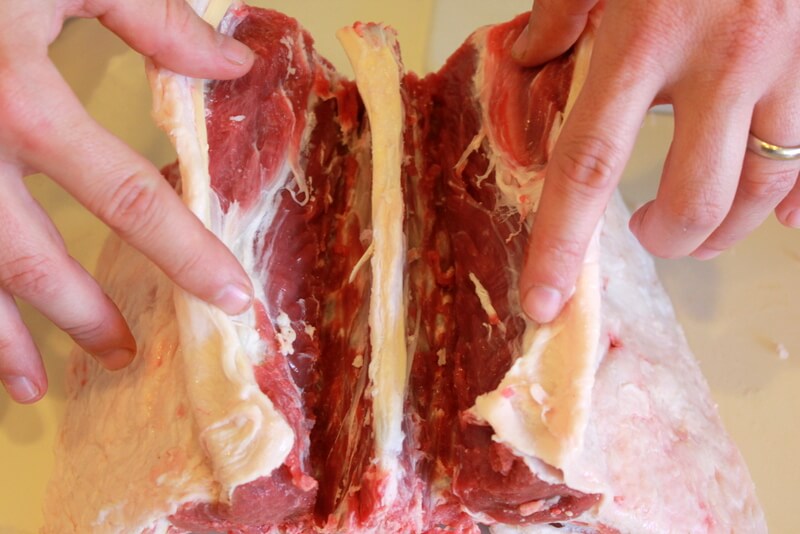
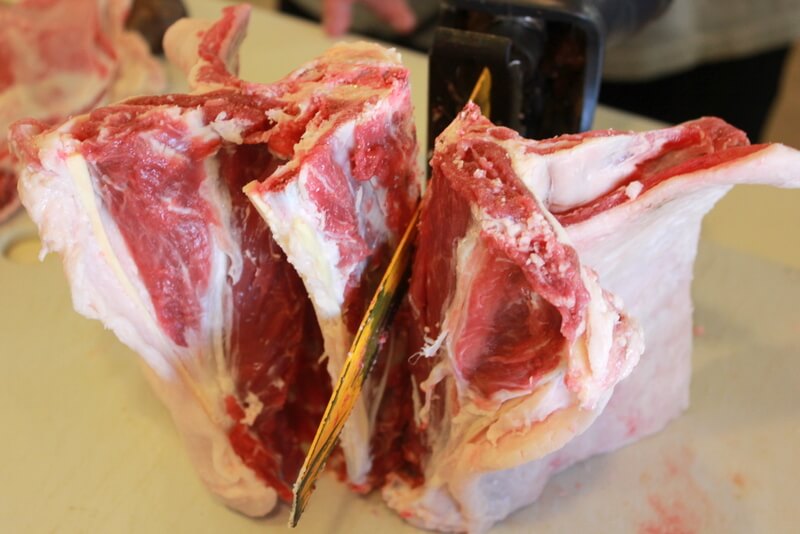
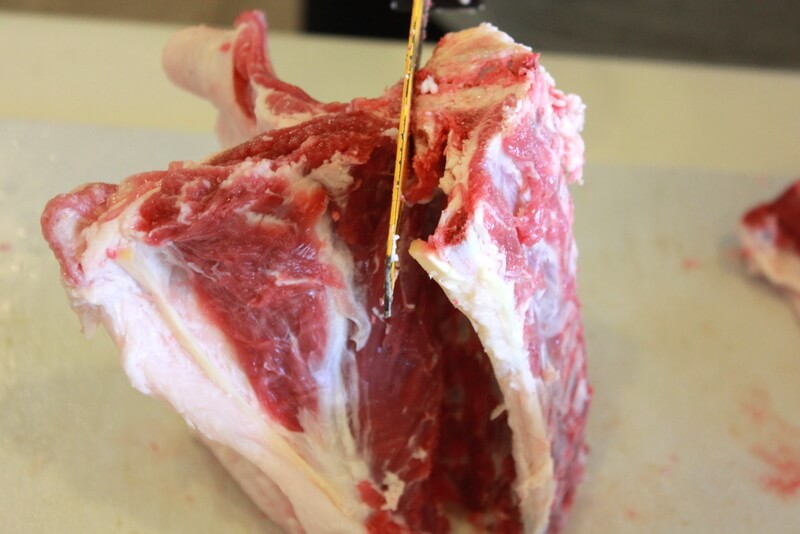
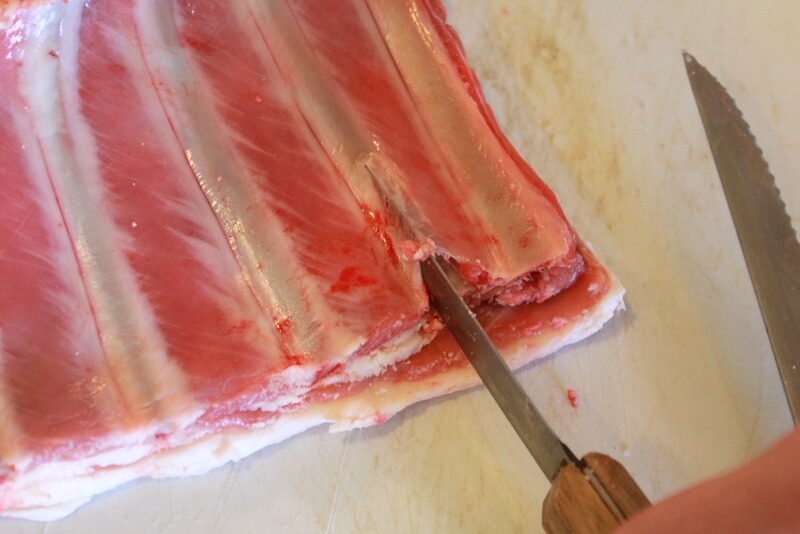
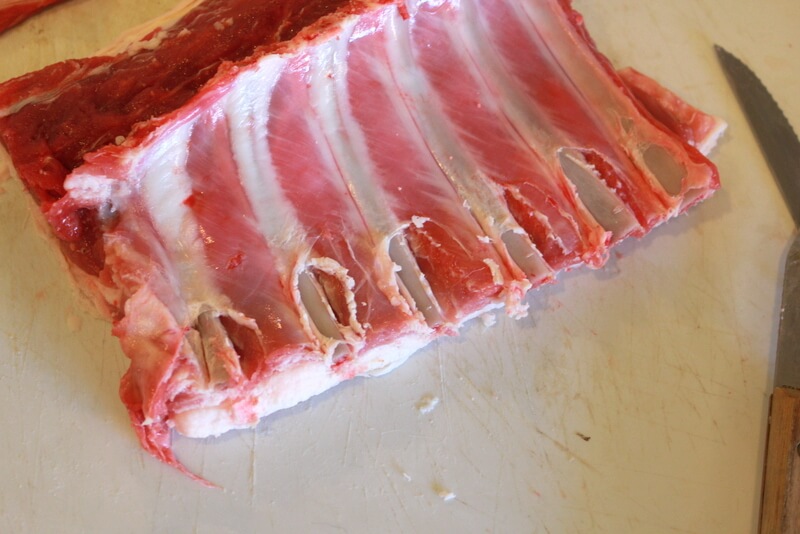
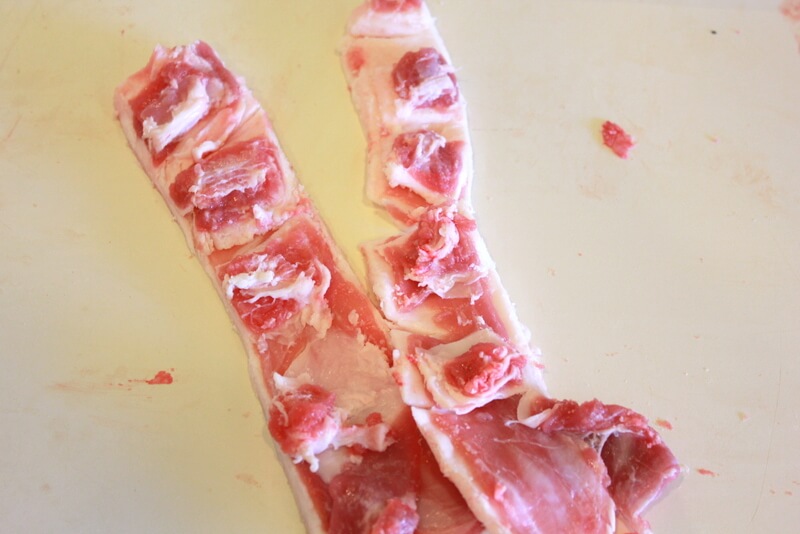
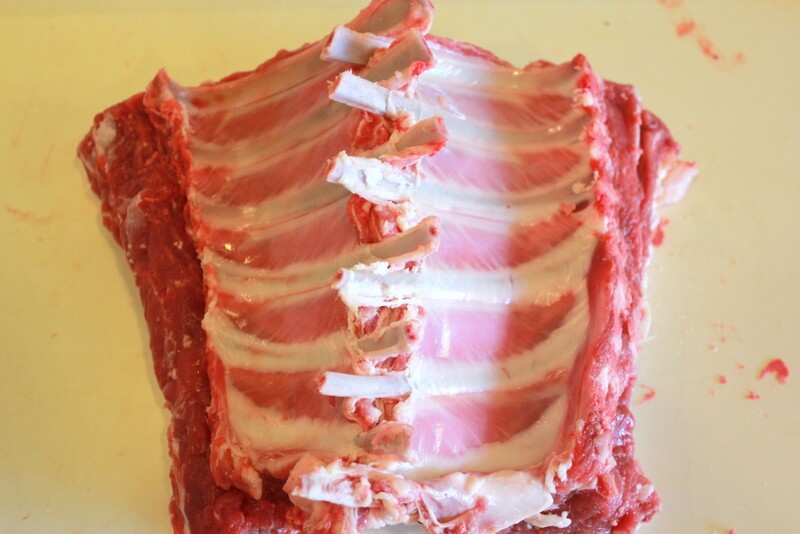
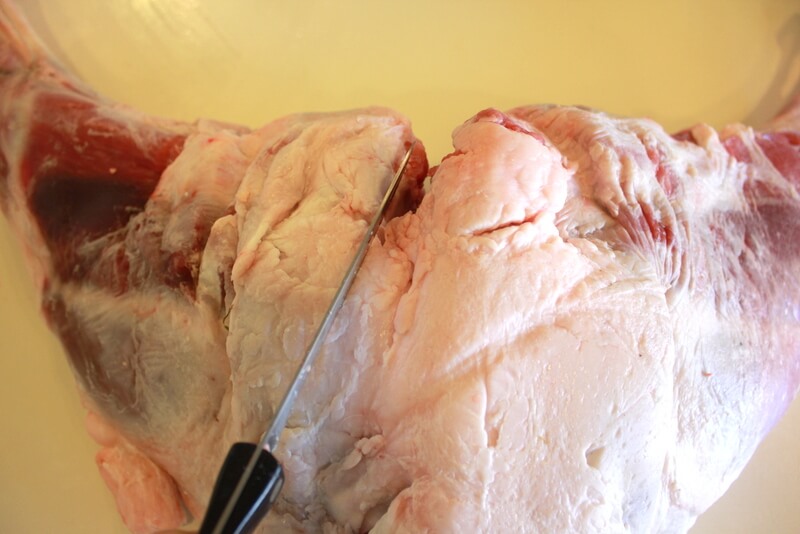
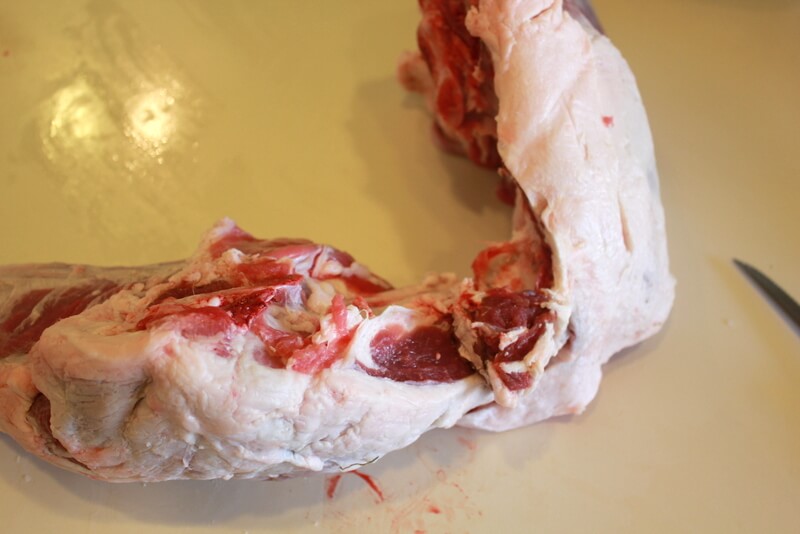
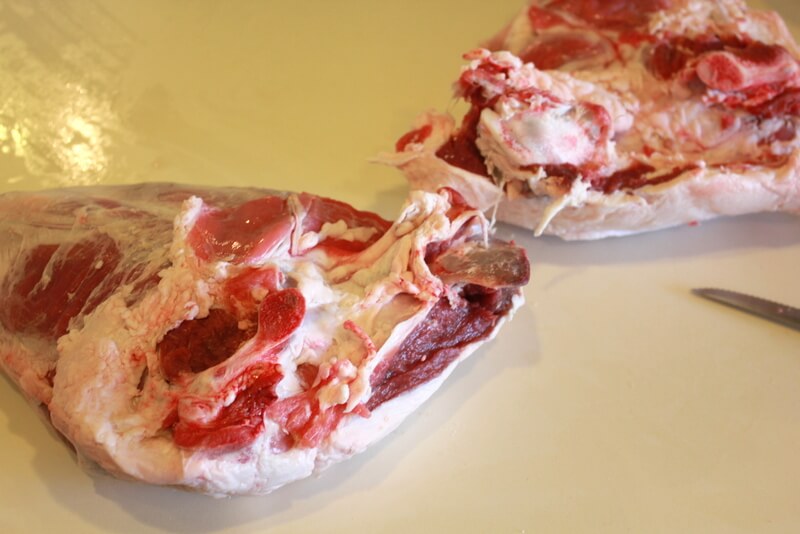
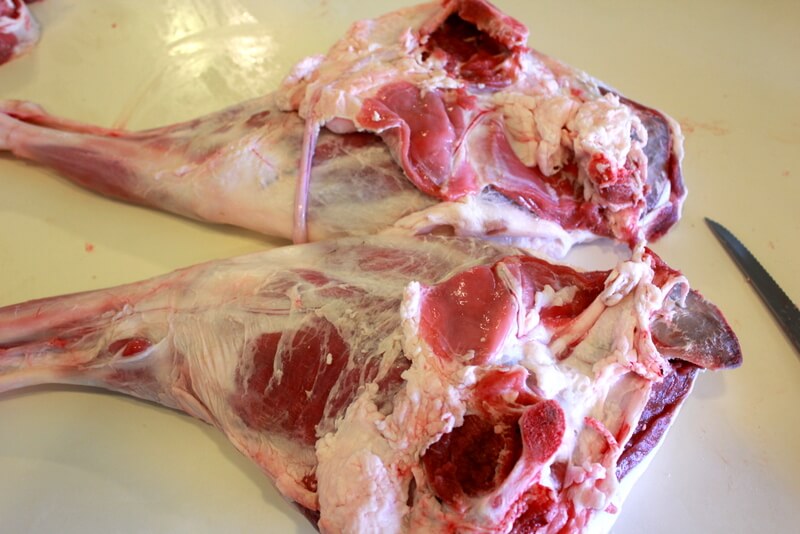
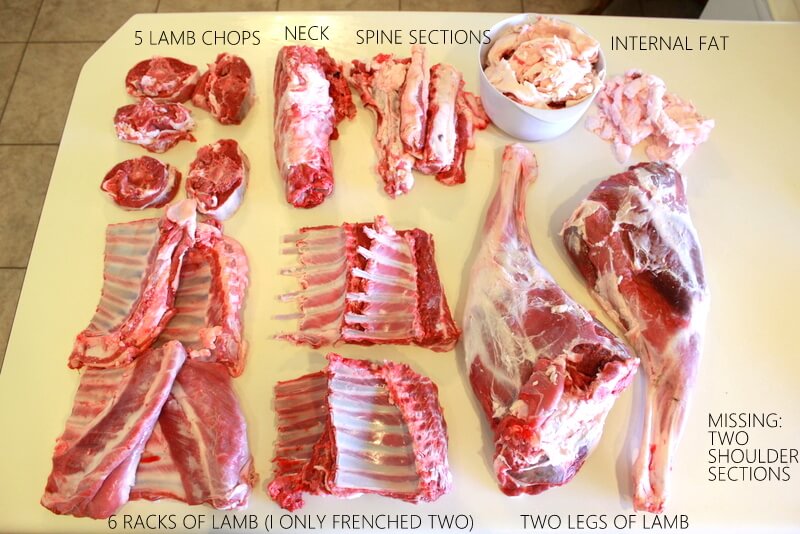
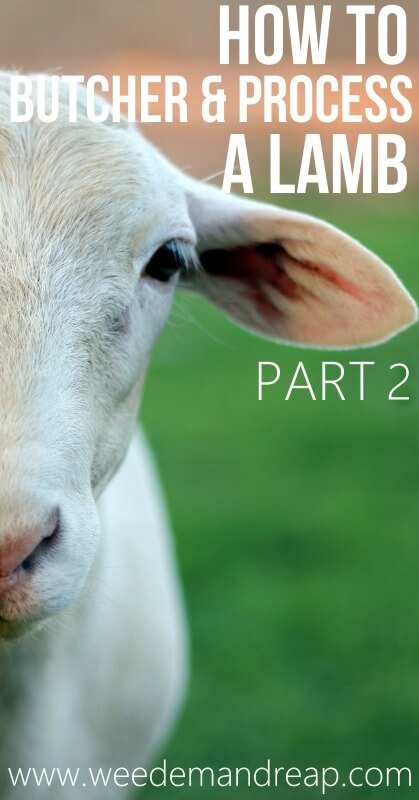

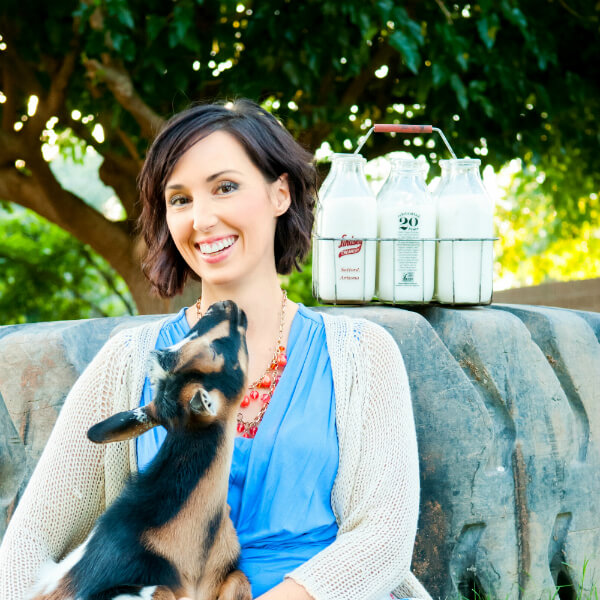
Hello, I recently had two ram lambs butchered they were almost a year old. We got the meat back from the butcher shop and cannot eat any of it. It has the worst smell and taste to it, it is extremely gamey and tastes like the sheep smell in the field if that makes sense. What went wrong? I plan on butchering my own lambs from now on, but if they taste like that I will not do it for long. Any help would be appreciated.
Thanks
Hi Christopher-
Lamb does lend itself to the gamey taste. Cuts of meat with more fat will have more of that flavor. One thing you can do to reduce the gamey taste is to soak it in milk for 8+ hours before cooking.
Thank you -Bobbi (DaNelle’s Assistant)
My Father always taught me the older the stinkier so he gets his lambs from about 5-8 months old he likes sheep better than goat but he only likes them from that age and he wants them very big.
Absolutely amazing! You make me want lambs yesterday! Or last year! 😉
hello I must say that lamb, goat, are very easy to raise. I have had dairy goats for most of 20 years, we live in central Illinois & the lamb, goats are butchered the same as deer witch we hunt & taste a lot alike but domestic animals do not seem to me to have a gamey flavor unless extremely stressed. I am glad that you posted this very natural & familiar process so more people see how its done & learn more about the food they eat. it just doesn,t by some miracle end up on your grocery shelves & freezers !
Thank You
Have you considered collecting the blood in a bucket of corn to feed to pigs? Friends of our report that this keeps the blood from clotting and its great for the pigs!
Pretty hardcore..How was it that the meat tasted so much better? Im not a doubter just curious
We did this last year at my house with some guys who were staying with us from Saudi Arabia. It never would have occurred to me to slaughter animals in my back yard, but apparently most normal families there do it every month or so. Actually, it was a good experience. As far as the killing, I was a little nervous, just because the only other thing I’ve killed is a fish and I didn’t want him to suffer, but I had a sharp knife after he relaxed it wasn’t hard. He didn’t fight. He basically just accepted his fate. I would just say to make sure your knife is REALLY SHARP. I used a Chef’s knife from the kitchen which was about 8″ long and razor sharp. It would be very cruel to use a dull or small knife… The meat is probably the best you will ever taste it’s almost with a nutty flavor. I love beef too, but the lamb is more flavorful and significantly less fatty than beef. If you just cut a chunk of the back leg rub it with spices and throw it on the BBQ it’s one of the most delicious things ever and the whole neighborhood can smell delicious aroma of lamb fat dripping on the hot coals. There was a lot to go around too, about 40lbs, I gave some to my friends and it still lasted for 3 months and we still have some stomach and intestines in the freezer. The leg bones I smoked and gave to my friends dogs. They really go crazy for them! You could even hear the dogs from the opposite subdivision barking, when we were butchering him because they could smell what was happening. I didn’t eat the heart, but as far as for the liver, the kidneys, stomach and intestines, go they actually tasted delicious and I have yet see it available in any supermarket or butcher. The brain was kind of gross honestly. It’s a delicacy in some countries and extremely high in Omega-3 fatty acids but I didn’t really like it. The eyeballs and meat on the face of the lamb tasted pretty good, but the brain just kind of tasted very fatty and had the texture of mushy seafood. I would probably try it again though… It definitely is an acquired taste. At the store, all I see is cuts of lamb from OZ or NZ that are probably two-three weeks old traveled over the pacific ocean and are priced anywhere from $6 a pound for ground lamb to nearly $30 a pound for the rib section.., So basically you pay $100 to $200 for a lamb and with a little bit of work, you have $400 to $500 of the best quality of meat (I’ve tried lamb from Safeway and it’s like %50 of the quality of fresh lamb you butchered). It took me and our student working by ourselves with no previous experience in butchering one whole afternoon, but I’ve seen guys on youtube kill, skin and quarter a lamb in 1 hour. I haven’t eaten lamb since then and I was kind of hesitant to do it again because I live in the Suburbs and people might think it’s weird or something, but it’s completely legal and I plan on buying another mouthwatering lamb this week.
Thanks for the insight!
This is an odd question, but do you know of any information on harvesting the blood as well? Somehow blood dishes have a bad rep in the US, but it seems a shame to waste a delicious and useful part of the animal!
Hey Carla, it’s maybe a bit late, but I hope this information helps. Where I live (Southern Chile), the blood is always used in a traditional indian recipe that is still very popular amongst locals, it’s called ñachi, and i found that the wikipedia entrance on it is very accurate (I tried it once, and nope, thank you, I’m Belgian). Here’s the gist of it:
Ñachi or ñache is a Mapuche food from Chile, prepared with fresh animal blood and dressings.
Blood of lamb or pig is preferred. The blood is mixed with coriander, merken or chilli, salt and lemon juice. As soon as the blood coagulates, it is cut in cubes and served with bread.
Note by myself: And white wine.
Hi we are raising Katahdin meat sheep and are getting ready to buther one of our rams. Was wondering how many days you hang your lamb?
Do you hang it whole or just refridg it for a certain number of days in the fridge already cut up?
Do you remove the testicles of the rams before butchering?
Do you tan the hide?
Thank you
I usually refrigerate instead of hang, but that’s because we live in Arizona and it’s too hot to hang. We refrigerate for a week. We have done it both ways — we’ve removed and left them and the meat has tasted fine both ways. I don’t tan the hide because we haven’t ventured into hide tanning yet!
Great post! What type of saw did you use or do you recommend? Thanks!
I keep coming back to reread this process. You should show what you’ve done with some of the lamb in recipe form. Any cool recipes that are out of this world? 😀
I’ve yet to butcher my own animal, but Immsure it will happen sooner than I think! When I first began homesteading I thought I would never eat organ meats/raw milk/home made broth, etc. And look at me now!
Hello! I am addicted to your site! I plan to raise goats for dairy purposes, but whatever whethers I don’t sell as pets or eco-clearing, will likely be butchered, along with a couple of hogs a year. I am researching different options, the one in the forefront right now is a mobile butcher if one can be found in the area I decide to settle and farm. So, a couple of questions regarding at home butchering. Does the blood smell or any other part of the butchering process distress any of your other animals? What about cleanup, do you place a tarp or anything under the animal to catch spillage so it doesn’t get into the grass and attract flies and lead to maggots? (I did notice that you placed a tub under the lamb’s neck, but did it suffice?) My other question is about meat prep/storage. I’ve read that any meat immediately going into the freezer looses its tenderness and becomes rather tough. Do you either wet or dry age the meat first? If not, how would you rate the results of what you did do? Last question. For the pricing part, you said that you already owned the dam, so you only had to pay the breeding fee. About how much did the ewe cost you? Did you buy her as an adult, or raise her from a lamb? Thanks so much! Your blog contains such helpful information, I’m always on it (when I should be working, I’m planning my next incarnation as a dairy goat and alpaca farmer!)
Lots of questions:) Okay, here goes.
1) No, the blood doesn’t smell and everything pretty much smells fresh unless it sits around for a while.
2) We don’t place a tarp down, we first drain most of it in the beginning when the animal is killed, but afterwards, we let anything drip onto the grass and it doesn’t attract flies/maggots because the ground soaks it up.
3) We wrap our meat in bags and store in the fridge for a week to tenderize it before freezing.
4) Our Ewe cost us $150, and that was with her already pregnant.
I will faithfully follow all instructions! I love every part of a lamb. I have never dressed out any animal. I have my small farm and are wanting to be more resilient so lambs, pot chickens, turkeys and a pig will be raised each year until eaten and then start over again. I will have the grass for two lambs and just thinking getting over animals you have loved and cared for will be the hardest part when they sit on my plate. I am many different nationalities but consider myself Armenian. I love raw lamb, kibbee, and will absolutely make this for my family with the first lamb processed. I cannot wait. Thank you for assuring me that treating an animal humanely and then taking its life for our nourishment is ethical and worth doing… BOB
So… you wouldn’t want to… say sell some your home grown lamb? I live in AZ and my son’s birthday is coming up. We are home schooling our four kids and we have been studying the Israelites. So my son, who’s birthday is in April, decided that he would really like to have the theme of his birthday dinner be… Passover. O-kay… Great learning experience… and getting lamb isn’t too hard, but getting GOOD lamb is a different story. I remembered this post and thought… maybe DaNelle would be willing to sell us some… 🙂
I wish I could, but this year we only raised enough for our family:)
Bummer 🙁 Okay, we’ll risk some market lamb.
We bought a leg of lamb at AJ’s. Pretty pricey, but… it was a good cause. I can totally see why you raise your own lambs. I thought the meat would be gamy and well… kind of gross. I couldn’t have been more wrong. It was amazing! I keep thinking about it even now. SO GOOD! Tender and tasty! Yes. So… now I just need to move to a house without an HOA. Hmmm….
Those dang HOA’s! 😉
Hello there~ Thank you for sharing this information! I have just a quick question and I hope it doesn’t sound critical because it really isn’t meant to be. I have always been told the most humane and swift way of killing a larger animal is to shoot them, and that to tie them and use a knife on their jugular creates fear/pain which puts adrenaline in the meat and makes it less tasty. The farmer that I am learning from shoots them with a small handgun in the temple at close range as they are first nibbling on a grain treat. Is there a reason why the technique you use is preferable to you? Thank you, once again, for your willingness to share information and photos. Very Sincerely, Becca
we use a hand gun or rifle also but usually midskull we still use the head meat but I suppose the knife would prevent bone chips which we do have to remove As far as the ‘terror factor” the reason the Chinese slit the jugular on chickens (slowly and calmly) is because they save the blood (for soup) and the chickens remain calm and bleed out very neatly. so I don’t think the lamb will get stressed unless you do. personally I use a rifle.
Becca,
We feel like a knife is more natural than a gun, you could even say maybe it’s the way nature intended? I’m sure using a gun is fine, but I’ve also heard that by using a knife on the jugular, the fast heart rate helps push more blood out of the body (and meat) than the other methods.
best tutorial on lamb butcher ever thanks
Thank you!
Wow. This is all really impressive (especially the savings! Wow!). What do you do with the spine sections? Is there still a lot of meat on them, or are they more for making bone broth?
Yes, exactly. I use those pieces for making some delicious, nutrient-dense broth!
Hi! How long does your family typically eat off of one lamb?
It takes our family of four 6 months if that’s all the meat we have, and 1 year if we have other meat.
Love it!…how do you prepare the sections that are either large (legs) or unfamiliar (spine) ?
Also, is there a list of what internal organs are usable?
Thanks-happy blogging!
Great pictures! Love the detail, and definitely approve of home bred meat! Just a little spell check for you 🙂
Towards the end you write this:
Here’s the FINAL PICTURE! The only thing mission from this picture is the shoulder pieces, and the heart & liver.
Edit:
Here’s the FINAL PICTURE! The only thing missing* from this picture is the shoulder pieces, and the heart & liver.
Have a good day! 🙂